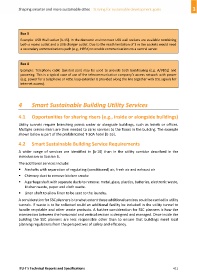Page 421 - Shaping smarter and more sustainable cities - Striving for sustainable development goals
P. 421
Box 3
Example: USB Wall socket [b‐15]. In the domestic environment USB wall sockets are available combining
both a mains outlet and a USB charger outlet. Due to the reach limitation of 3 m the sockets would need
a secondary communications path (e.g., HPPA) to enable communications to a central server.
Box 4
Example: Telephony cable (twisted pair) may be used to provide both backhauling (e.g. A/VDSL) and
powering. This is a typical case of use of the telecommunication company’s access network with power
(e.g. power for a telephone or ADSL loop extender is provided along the line together with DSL signals for
internet access).
4 Smart Sustainable Building Utility Services
4.1 Opportunities for sharing risers (e.g., inside or alongside buildings)
Utility tunnels require branching points under or alongside buildings, such as hotels or offices.
Multiple service risers are then needed to carry services to the floors in the building. The example
shown below is part of the prefabricated T‐30A hotel [b‐16].
4.2 Smart Sustainable Building Service Requirements
A wider range of services are identified in [b‐16] than in the utility corridor described in the
introduction to Section 6.
The additional services include:
Airshafts with separation of regulating (conditioned) air, fresh air and exhaust air
Chimney duct to remove kitchen smoke
A garbage shaft with separate ducts to remove: metal, glass, plastics, batteries, electronic waste,
kitchen waste, paper and cloth waste.
Linen shaft to allow linen to be sent to the laundry.
A consideration for SSC planners is to what extent these additional services could be carried in utility
tunnels. If waste is to be collected could an additional facility be included in the utility tunnel to
handle recyclable and other waste products. A further consideration for SSC planners is how the
intersection between the horizontal and vertical section is designed and managed. Once inside the
building the SSC planners are less responsible other than to ensure that buildings meet local
planning regulations from the perspectives of safety and efficiency.
ITU‐T's Technical Reports and Specifications 411

